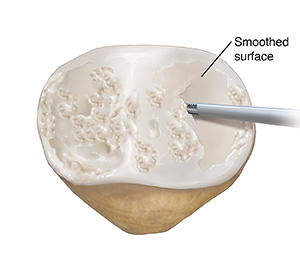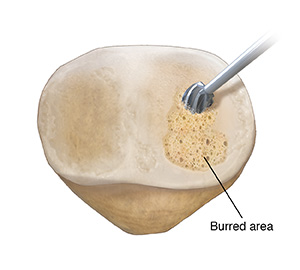Kneecap Surgery: Removing Damaged Cartilage
Surgery may be used when pain severely limits your activities. Or it may be done when a rehab program or other nonsurgical treatments just are not helping enough. Some procedures may be done using arthroscopy. This method uses tiny cuts (incisions) and special tools to look and work inside the knee joint. Other procedures need open surgery.
Cartilage removal
Damaged cartilage is taken out from the back of the kneecap or from the groove in the thighbone. This is often done using arthroscopy.
Debriding
This method removes damaged cartilage on the kneecap or thighbone (femur). It makes a smoother surface between them.

Burring
This procedure is done when the cartilage is worn down to the bone. Burring into the bone reaches the blood supply. This allows a new fibrous covering to grow.

Recovering from surgery
As you recover, you can aid the healing process by taking it easy at first. Follow your surgeon's instructions. Your knee may be bandaged, wrapped, or iced to keep swelling down. You may be given a brace to protect your knee. This helps improve your range of motion and speed healing. Keep your leg raised above your heart so fluid can drain away and swelling is reduced. Surgery is often followed by a rehab or physical therapy program.
© 2000-2024 The StayWell Company, LLC. All rights reserved. This information is not intended as a substitute for professional medical care. Always follow your healthcare professional's instructions.